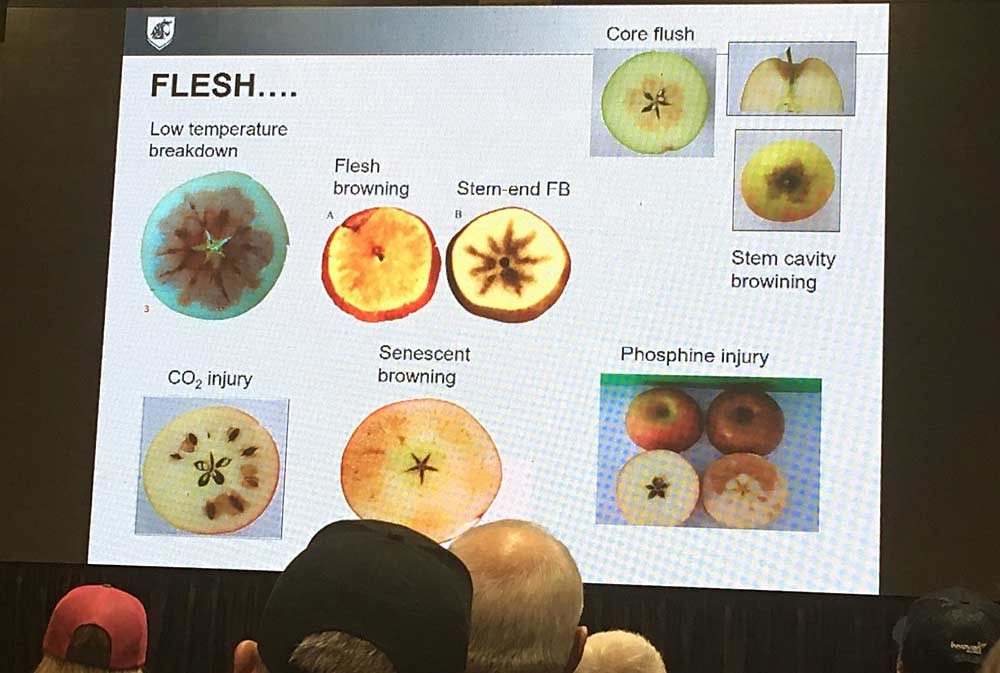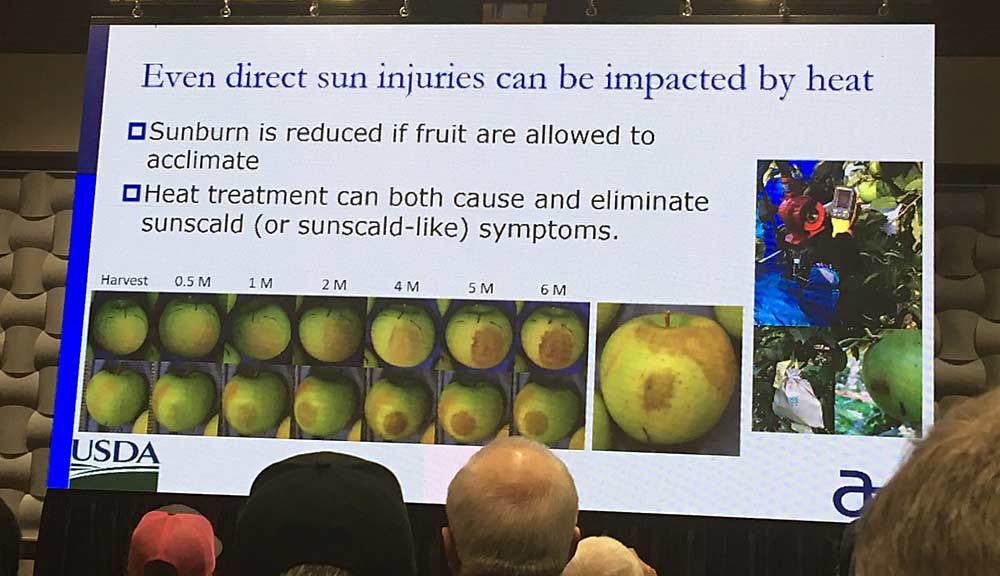
The success of a growing season often comes down to when to pick and how best to store apples. That’s why one morning session at the Washington State Tree Fruit Association’s Annual Meeting focused on fruit quality metrics and postharvest management.
Panelists from the warehouse side of the equation shared insights on tools for assessing maturity and making good pick decisions. Aylin Moreno, fruit quality analyst for McDougall & Sons, said she collects sugar, acid, pressure and starch data a week before harvest to help guide decisions.
But even more important is using similar data from harvest samples and comparing it with past data to understand fruit quality and storage potential. “What I’m trying to do is create a ratio for each variety of what is the changes we should be seeing for long-term storage,” she said.
Juan Rodriquez, the QC receiving manager at Stemilt Growers, said he relies on harvest and storage plans that have set standards, so he can figure out where fruit fits based on quality metrics. Keeping growers on the same page on those plans and standards helps everyone succeed, even when pick plans have to change at the last minute.
“You can generate all the data, but if you don’t have someone who knows how to digest that information to make a better decision for the warehouse, you just have a bunch of numbers,” he said.

But a major — and likely growing — challenge stems from the fact that common maturity indices can perform differently depending on the growing season climate, said Carolina Torres, the endowed chair for postharvest physiology at Washington State University. She joined WSU last year, leaving a faculty position in Chile where she researched the impact of growing season heat and humidity on fruit stress and how that impacts disorder development.
“When we are facing a warm season, we just harvest earlier with the same indices we usually use, we think everything is fine,” she said. But indices may not line up like normal (starch clearing before good color development for example) and rapidly ripening fruit continues to mature on a fast track in storage. “When that happens, fruit softens really fast,” she said.
Application of 1-MCP can prevent these disorders associated with this hot fruit, but for organic storage, these climate impacts can complicate storage decisions, Torres said.
U.S. Department of Agriculture physiologist Dave Rudell said that in recent seasons, Washington-grown Galas have developed some disorders more common in warmer growing regions.
Emerging research to look at fruit biomarkers may be able to better measure maturity and stress, and predict disorder risk, Rudell said, including new tools now being developed by AgroFresh.

Also included in the session was a panel about Food Safety Modernization Act compliance and the experience of participating in the voluntary, educational On Farm Readiness Reviews conducted by the Washington State Department of Agriculture. Jeremy Leavitt, food safety director for Borton Fruit, said the practice-test-style FMSA review was pretty much in line with everything he was already doing to be in compliance with GlobalGAP and other customer audits.
Daniel Donahue of Cornell Cooperative Extension spoke in the soils and nutrition session of the annual meeting. Somehow, applying Apogee early in the season suppressed the incidence of bitter pit in trials in the Hudson Valley of New York, he said .
He’s not sure why.
“We really don’t know at this point why it works,” he said.
Growth regulators applied at pink bloom led to roughly a 50-percent reduction in bitter pit incidence, over control, throughout three years of trials, Donahue said.
The treatments did little, if nothing, to change shoot growth or calcium levels in leaves and skins. Bitter pit is generally blamed on calcium deficiencies. While Donahue doesn’t dispute that, he believes the relationship is more complicated.
“It’s not just a matter of taking your vitamins,” he said.

Other presentations during the session included a study of tree growth using legumes as cover crops and comparing the incidence of bitter pit in trees grown on different rootstocks.
Tuesday’s proceedings in the afternoon will include sessions about tree fruit physiology, pollination and crop load management, and an evening awards banquet.
—by Kate Prengaman and Ross Courtney
Related:
—Revealing risks with RNA
—Sunburn and sunscald: Beware the warning signs – Video
—State agencies offer readiness reviews for FSMA inspections






Leave A Comment